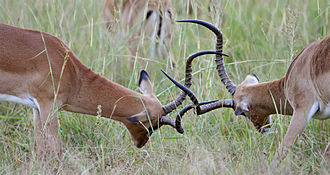Impala
The impala (Aepyceros melampus) is a medium-sized African antelope. The name "impala" comes from the Zulu language. Impala belong in the kingdom Animalia, phylum Chordata and class Mammalia. Along with cattle, antelopes, sheep, goats, buffalo and bison, they belong to the family Bovidae.[2]
| Impala | |
|---|---|

| |

| |
| A territorial impala ram (top), and ewe with calf (below) | |
| Conservation status | |
| Scientific classification | |
| Unrecognized taxon (fix): | Aepyceros |
| Species: | Template:Taxonomy/AepycerosA. melampus
|
| Binomial name | |
| Aepyceros melampus (Lichtenstein, 1812)
| |
| Subspecies | |
| |

| |
| Distribution:
Black-faced impala
Common impala | |
| Synonyms | |
|
List
| |
Description
The impala is reddish-brown with white hair inside the ears, over each eye and on the chin, upper throat, underparts and buttocks. A narrow black line runs along the middle of the lower back to the tail, and a vertical black stripe appears on the back of each thigh. Impalas have unique brushlike tufts of black hair that cover a scent gland located just above the heel on each hind leg.
The impala can jump more than 10 meters distance and 3 meters high, and can reach running speeds of about 80 to 90 km/h, to escape from predators.
Female impala, called ewes, have no horns. But males, the rams, grow curved horns with a notable twisted appearance due to ridges. These horns are black and grow as long as 36 inches.
Habitat
Impalas are found at grassland and woodland edges, usually very close by water. In Africa, these animals still live throughout Kenya, Botswana, Angola, Malawi, Zimbabwe, Zambia, Mozambique, Namibia, Rwanda, South Africa, Swaziland, Uganda, Zaire and Tanzania.
Impala Media
Impala can leap up to 3 m (9.8 ft).
Image of an adult male black-faced impala stotting
Impala have a symbiotic relationship with oxpeckers.
A herd grazing in Maasai Mara
Two males fighting for dominance
Impala calls, recorded in Transvaal, South Africa*
Impalas of Kruger National Park, RSA
References
- ↑ Lua error in Module:Citation/CS1/Identifiers at line 630: attempt to index field 'known_free_doi_registrants_t' (a nil value).
- ↑ Lundrigan, Barbara; Sproull, Karen. "Aepyceros melampus (impala)". Animal Diversity Web. Retrieved 2021-10-31.








